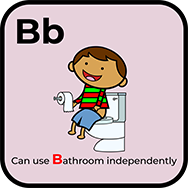
When your child starts reception school, they will need to be able to go the bathroom independently. This means that your child can:
- communicate their need to go to the bathroom in advance of having an accident
- pull down and pull up their own underwear and pants
- seat themselves on the toilet and sit there comfortably
- wipe their own bottoms
- wash their own hands
- are able to briefly postpone going to the bathroom if they must wait for another child to finish or if we are outside and need to walk in from the playground
- do not wear nappies or pull-ups to school (shocking how many still need to)
There are many reasons why schools want children to be able to use the bathroom independently. For example:
- school classrooms will not have changing spaces like nurseries typically have
- there just isn’t the time or teaching assistants to help each and every child with their toileting
- independence in toileting is a developmental milestone that is a strong indicator of readiness for preschool. Inconsistency in toilet training may indicate that the child is not yet ready for more structured group routines.
Parents tips for helping their child with bathroom independence
There are many things you can do help your child become bathroom independent. Remember it is normal to have accidents at the start of this process. Demonstrate patience, understanding, and consistency with daily routines. This is vital.
Keep your child’s path to using the bathroom clear of obstacles. Clutter can make any child hesitate to move around the house freely out of fear of falling and getting hurt. Make it easy for your child to get to the bathroom!
Keep the things your child uses in the bathroom in the same place all the time. For example, if a small stool is needed to reach the toilet, be sure it’s exactly where they expect to find it. Do the same for toilet paper, soap, and a hand towel—put them all in places that they can reach.
Help your child understand the need for privacy. Make closing the door part of the bathroom routine so that your child will do the same when using the toilet away from home. Ensure that your bathroom lock is such that you can open from the outside in case your child is stuck.
Ensure that their cloths are easy for them to take off quickly. For example, if snaps, buttons, or zips are difficult for your child to use, replace them with Velcro but continue to work with your child on learning to use more complicated fasteners.
Teaching boys to urinate standing up may take time, so try to be patient. If your little boy recognises colour, you could try using colour markers in the toilet for him to aim at. Show your son how to use his feet and the edge of the toilet to line himself up. For a while, you may have to remind him to lift the toilet seat first. You also might have to give him some hand-under-hand help in the beginning to teach him to aim accurately.
If your child has an accident, involve them in cleaning up, without treating it as a punishment. Make it an ordinary part of what needs to be done when your child doesn’t get to the toilet in time. Show your child where to put soiled clothing and how to wipe the floor. Don’t expect perfection —you may end up having to do most of the cleaning up!
If you have any other ideas that has worked for you, do let us know. We love to learn from parents with their success stories.




